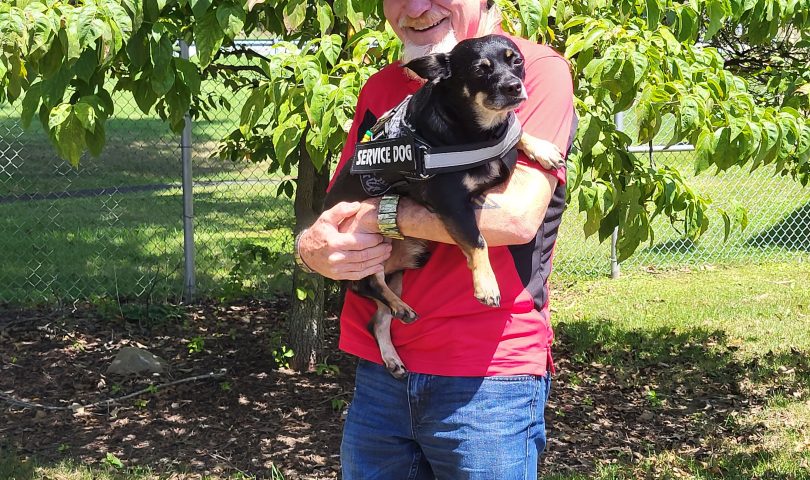Most people have seen or come into contact with a service animal. Many also have an idea of what the rules associated with service animals are – many of are also wrong.
Local U.S. Army veteran Kenneth Costello and his service dog Bugsy do not fit common stereotypes associated with service dogs. Costello, a retired first sergeant who served for 21 years, stands tall and, from an outside perspective, seems to get around fairly well. Bugsy is small – barely taller than Costello’s ankles – and is far from a pure breed.
While the average passer-by might not see it, Bugsy is making sure Costello is not becoming agitated or anxious, common occurrences before or during an anxiety attack of a person with Post Traumatic Stress Disorder (PTSD).
When Costello shows signs of an attack, Bugsy will immediately jump into action – sometimes literally – to help calm him down, let him know he is there, and everything is fine.
You may not even realize when a dog is helping their owner through an anxiety attack.
Abby McElwee, assistant trainer at Hearts of Gold – a local service dog training program funded through the Wounded Warrior Project that provides service dogs for individuals with mobility impairment and/or PTSD – said there are several things dogs are trained to do when assisting owners with anxiety.
“Our dogs are taught to kind of swat at the handler’s foot if they shake their leg or tap their foot,” she said. “Or if they rub their hands because they’re nervous or bite their nails, the dog will come up and kiss them on the face to stop them from biting their nails or boop their nose into their hands to kind of interrupt the anxiety action.”
While Bugsy wasn’t trained professionally, he is still able to perform this service for Costello.
Costello said he and Bugsy have been denied service at several local establishments and are often questioned by uneducated staff and business owners.
“People just don’t know the rules and it’s not right,” he said. “I just want to get the information out there.”
Service animals are defined by the Americans with Disabilities Act (ADA) as dogs that are individually trained to do work or perform tasks for an individual with disabilities. The task or tasks performed by the dog must be directly related to the person’s disability.
The work or tasks performed by service animals range from guiding the blind or deaf, pulling or retrieving objects for people in wheelchairs, alerting to and protecting a person who is having seizures, reminding owners to take prescribed medications, calming a person with PTSD during an anxiety attack, and many other services.
Under the ADA, state and local governments, businesses and nonprofit organizations that serve the public must allow service animals to accompany their owners in any area the public is allowed.
While there are a few exceptions, like hospital operating rooms where the sterile environment cannot be compromised or places exempt from the ADA like religious institutions, the vast majority of public places must allow service animals to be with their owners.
Service dogs do not have to be a specific breed, size, or age. People with disabilities can train their dog themselves and are not required to participate in any professional service dog training programs.
The ADA does not require service animals to wear a vest, ID tag, or any specific harness that identifies them as a service animal and businesses cannot ask or require documentation like proof that the animal has been certified, trained, or licensed as a service animal as a condition for entry or service.
In fact, there are just two questions businesses may ask someone entering with a service animal – “Is the dog a service animal required because of a disability?” and “What work or task has the dog been trained to perform?”
Once those two questions are answered, staff cannot ask specifics about the disability or ask the dog to demonstrate its ability to perform the task.
However, if the dog gets out of the handler’s control or proves to not be housebroken, a business is then permitted to ask the animal be removed but must still offer the disabled person the opportunity to obtain goods and services without the animal present.
“These are things that nobody knows,” Costello said. “It’s not right, you know. They are taking away my rights and I don’t like it.”
The Vietnam veteran tries to be as prepared as possible when he and Bugsy hit the town. He carries a service animal ID card with Bugsy’s name and picture, a copy of his certification, and even got Bugsy his own “uniform” identifying him as a service dog.
The problem is he shouldn’t have to – and legally doesn’t have to – have any of that or prove anything to anyone.
“Service dogs are super important to mitigate their human’s disabilities and it’s not always something that’s visible,” McElwee said. She said, in general, it is best practice to try to not interact with service dogs and to teach your children the same.
“Remember they are doing a very important job at that moment in time and your interacting with them could keep them from doing their job,” she said.
If you would like to know more about the rules and regulations associated with service dogs, you can visit the ADA website at ada.gov and click on the Guidance and Resource Materials tab and select ADA Requirements: Service Animals.




